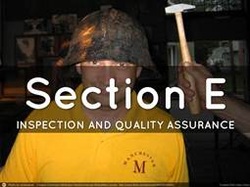Section E. Inspection and Acceptance.

Section E describes how the Government will inspect and officially accept delivery of services or items covered in the contract including inspection process, quality assurance (QA) and reliability requirements. Contract quality requirements required under the contract are based on the classification of the contract item (supply or service) as determined by its technical description, its complexity, and the criticality of its application. The levels range from reliance on the contractor’s commercial practices to detailed specifications for a contractor QA program. The purpose is to ensure the Government is getting what it is paying for under the terms of the contract.
The following items should be included in Section E:
If you are bidding commercial items, First Article Inspection and/or Test requirements should appear in this section.
REVIEW ACTION
Inspection and acceptance descriptions may be included in FAR clauses that are only incorporated by reference, so you should locate and review them in full text to understand their impact on your response. There may also be references to Section H, Special Contract Requirements and Section I, Contract Clauses. Be on the lookout for whether inspections occur on-site or off-site and whether a DCMA audit is required.
It is not usually of direct interest to the financial manager; however, it may become important if inspection/acceptance problems delay payments, putting the program behind schedule on its expenditure plan.
SUCCESS TIP
Be sure to account for any Section E requirements or tasks in your cost proposal and, if required, your integrated master schedule.
SUBMISSION ACTION
Check to see that QA requirements are consistent and compatible with those listed in Section C. If there are obvious contradictions or inconsistencies, bring them to the attention of the contracting officer.
Your proposal should acknowledge the Government’s inspection requirements by including them in the description of your inspection system, records maintenance, and any testing that must be conducted during certain points in the contract period. These should also be represented in your detailed program schedule or integrated master schedule, if required by the RFP.
WARNING
Section E is often overlooked by small businesses. Inspection and acceptance activities must be factored into your delivery schedule and pricing, if not, the financial implications could be disastrous.
In extreme cases, the Government agency can have another contract perform the services or deliver the goods and charge associated costs to you.
Watch for hidden proposal instructions and fill-in the blank items. The fool-proof method involves reading the entire section, end-to-end, and marking instructions and blanks with a highlighter.
The following items should be included in Section E:
- Basis of Acceptance
- Inspection/Acceptance Lead Times
- Rejection and Corrective Action Process
- Review of Deliverables
If you are bidding commercial items, First Article Inspection and/or Test requirements should appear in this section.
REVIEW ACTION
Inspection and acceptance descriptions may be included in FAR clauses that are only incorporated by reference, so you should locate and review them in full text to understand their impact on your response. There may also be references to Section H, Special Contract Requirements and Section I, Contract Clauses. Be on the lookout for whether inspections occur on-site or off-site and whether a DCMA audit is required.
It is not usually of direct interest to the financial manager; however, it may become important if inspection/acceptance problems delay payments, putting the program behind schedule on its expenditure plan.
SUCCESS TIP
Be sure to account for any Section E requirements or tasks in your cost proposal and, if required, your integrated master schedule.
SUBMISSION ACTION
Check to see that QA requirements are consistent and compatible with those listed in Section C. If there are obvious contradictions or inconsistencies, bring them to the attention of the contracting officer.
Your proposal should acknowledge the Government’s inspection requirements by including them in the description of your inspection system, records maintenance, and any testing that must be conducted during certain points in the contract period. These should also be represented in your detailed program schedule or integrated master schedule, if required by the RFP.
WARNING
Section E is often overlooked by small businesses. Inspection and acceptance activities must be factored into your delivery schedule and pricing, if not, the financial implications could be disastrous.
In extreme cases, the Government agency can have another contract perform the services or deliver the goods and charge associated costs to you.
Watch for hidden proposal instructions and fill-in the blank items. The fool-proof method involves reading the entire section, end-to-end, and marking instructions and blanks with a highlighter.
Go to Section F | View Bibliography